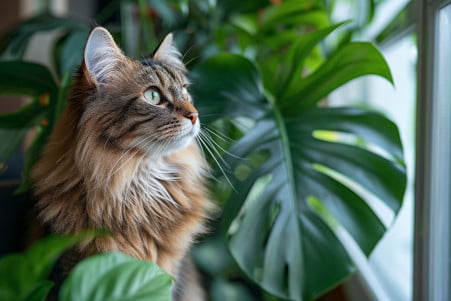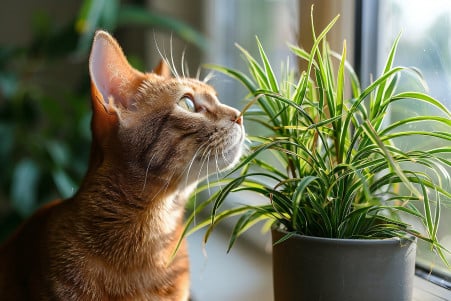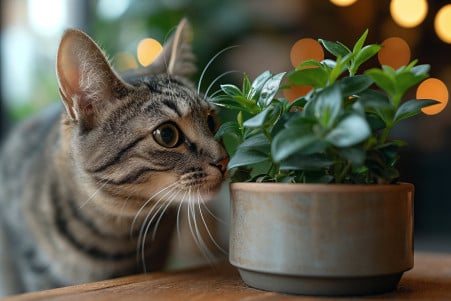Is Wandering Jew Plant Toxic to Cats? A Safety Guide
24 May 2024 • Updated 22 May 2024

If you have a cat and are thinking about bringing a wandering jew plant into your home, it's important to be aware of the potential risks of toxicity. Wandering jew (Tradescantia zebrina) contains soluble calcium oxalates, which can lead to oral and gastrointestinal irritation if cats consume the plant. This can result in symptoms such as drooling, vomiting, and difficulty swallowing. While it's not typically deadly to cats, it's still best to keep this houseplant out of reach to prevent accidental poisoning.
To help you better understand the toxicity of this plant and which parts of it are most toxic to cats, we've done a deep dive into veterinary research and expert insights. From case studies to plant analyses to treatment recommendations, you'll walk away with a better understanding of how to keep your cats safe around wandering jew and other toxic plants. With the right knowledge, you can enjoy the beauty of this plant without worrying about the health of your feline friends.
Is the wandering jew plant toxic to cats?
What Makes Wandering Jew Plant Toxic to Cats?
The wandering jew plant contains soluble calcium oxalates, which are the toxic compounds that can harm cats if ingested. According to Preventive Vet, these oxalates can cause severe irritation and ulceration of the mouth, lips, tongue, as well as difficulty swallowing in felines. Embrace Pet Insurance notes that the wandering jew plant belongs to the commelinaceae family and its toxins can lead to dermatitis in cats.
Although the toxicity level is listed as mild to moderate with ingestion typically not resulting in life-threatening situations, it's still important to keep the plant away from cats. Even a small amount of exposure can lead to symptoms like vomiting, diarrhea, and loss of appetite according to The Spruce. The severity of a cat's reaction can depend on how much of the plant they've eaten and their individual sensitivity to the toxins.
How to Tell If Your Cat Has Been Poisoned
If your cat has ingested wandering jew, you may notice a few symptoms. According to Cats Protection, these symptoms include drooling, vomiting, and difficulty swallowing. The organization also notes that skin irritation, such as redness, itching, or dermatitis, may occur if the plant comes into contact with the cat's skin or fur.
More severe symptoms include gastrointestinal issues like diarrhea, loss of appetite, and abdominal pain, according to PetMD. Larger ingestions can result in respiratory problems, lethargy, and neurological symptoms like tremors or seizures. PetMD also explains that the severity and duration of symptoms can depend on the amount ingested and the individual cat's sensitivity.
If you think your cat has eaten or come into contact with wandering jew, it's important to take them to the vet right away to treat any symptoms and avoid further issues.
First Aid and Veterinary Treatment for Wandering Jew Plant Poisoning
If you think your cat has eaten or come into contact with wandering jew, get veterinary help right away. Olympia Pet Emergency notes that you should try to find the plant and take a sample or picture to help the vet with the diagnosis and treatment.
Don't try to make your cat vomit or give them at-home treatments without consulting a professional because it could make things worse. Instead, says wikiHow, your vet may make your cat vomit, give them activated charcoal to absorb the toxins, or offer supportive treatment, such as fluids and anti-nausea drugs.
Getting treatment as soon as possible can help reduce the severity of the symptoms and the likelihood of complications. PetMD explains that your vet may also provide other treatments depending on the toxin and your cat's symptoms.
How to Avoid Wandering Jew Plant Poisoning in Cats
The most effective way to avoid wandering jew plant poisoning in cats is to keep the plant out of your cat's reach. Since cats respond differently to scents, it may take some trial and error to find the right scent to keep your cat away from your plants, according to The Spruce. The Spruce recommends using citrus oils or diluted vinegar sprays around the plant to keep cats away.
If you still want to keep the wandering jew plant, make sure to keep it in a hanging basket or on a high shelf where your cat can't reach it. Hill's Pet recommends planting cat-safe, non-toxic plants like wheat grass to keep your cat occupied and protect your ornamental plants. The Wildest also suggests growing orchids and African violets, which are safe for cats to eat.
You can also help keep your cat away from toxic plants by providing other forms of enrichment, such as cat grass or catnip, that can help satisfy their desire to graze. With these measures in place, you can enjoy the wandering jew plant's beauty without worrying about your cat's safety.
More Poisonous Plants to Keep Away From Cats
Aside from wandering jew, there are many other popular indoor and outdoor plants that can be harmful to cats. According to Preventive Vet, examples of very toxic plants include lilies, sago palms, azaleas, and rhododendrons, all of which can lead to serious sickness and even death in cats. Purina explains that even plants that are only moderately toxic, like aloe vera, philodendrons, and dieffenbachia, can lead to a range of health issues and discomfort if cats eat them.
Make sure to look up and learn about any potentially poisonous plants in your home or garden and take measures to keep your cat away from them. As advised by BBC Gardeners World Magazine, using references such as the ASPCA's list of toxic and non-toxic plants can help you make sure that your cats are safe.
Conclusion: How to Create a Safe Home for Your Cat and Your Plants
In order to create an environment that is safe and enriching for your cat, it's important to take both plant and pet safety into account. Go through your home and any outdoor areas to make sure that there are no toxic plants that your cat can access. If you find any, replace them with non-toxic plants that are safe for cats like wheat grass, orchids, or African violets.
Make sure that your plants are in areas that your cat can't get to by creating a plant room or using enclosed shelving. Make sure that you're providing your cat with enough enrichment and playtime to keep them from getting bored and turning to your plants for entertainment.


